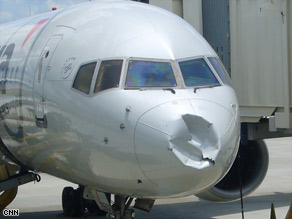FBI DIVERS' ROLE ON HUDSON RIVER
Underwater Search and Evidence Response Team Helped Pinpoint Lost Engine
This image from the FBI dive team's sector scan, or radial, sonar shows the engine from
US Airways Flight 1549 resting on the bottom of the Hudson River in New York.
The call came around 7 p.m. on January 15 as core members of the FBI Laboratory's Underwater Search and Evidence Response Team were training with Army divers in Virginia. US Airways Flight 1549 out of La Guardia Airport in New York had ditched into the Hudson River shortly after takeoff.
Six FBI divers quickly gathered their gear and caravanned up to New York at the request of the National Transportation Safety Board (NTSB), which follows a well-rehearsed protocol to call the FBI in cases where there's any suspicion of terrorism. With terrorism ruled out, the FBI divers from New York, Los Angeles and the FBI Lab in Virginia joined New Jersey State Police and New York Police Department divers on the scene to set about recovering missing pieces of the foundering plane.
We went up there with an eye toward diving for the black boxes, said Supervisory Special Agent Kevin Horn, program manager of the Underwater Search and Evidence Response Team (USERT), which has about 50 divers in four field offices, including the New York office in Manhattan.
Attention soon turned from recovering the black boxes to recovering one of the jet's engines, which had sheared off from impact. Investigators were focusing on reports that birds sucked into an engine may have brought down the plane. Recovery of the engine might reveal answers.
Finding the engine by sight was impossible in the frigid murky water. New Jersey State Police divers launched a boat onto the Hudson and trolled behind them a side-scan sonar, which helped narrow the field of potential locations for the sunken engine. The FBI then lowered a radial sonar about 60 feet to the bed of the Hudson, which captured a ghostly image (above) of what appeared to be the missing left engine.
Using sonar, FBI divers directed the U.S. Army Corps of Engineers in lowering a marker to within two feet of the engine. A NYPD diver then followed the marker rope to the bottom of the river where he confirmed it was the jet's engine.
While the circumstances and conditions were exceptional, Special Agent Horn said, FBI USERT divers are accustomed to challenging situations. The divers rely on their specialized dive training and technology in order to assist NTSB and other state, local, and federal agencies.
Horn went on to credit the cooperative effort in difficult circumstances for a successful mission.
This dangerous dive mission could not have been carried out as safely and as efficiently as it was without the coordinated efforts of the FBI's New York USERT, the divers of the New Jersey State Police, and the NYPD, he said.
)







